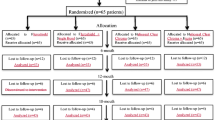Abstract
The objective was to evaluate the clinical performance of a therapeutic sealant to arrest the progression of noncavitated approximal posterior carious lesions. The study population comprised 50 adolescents in whom bitewing radiographs had been taken for diagnosis of caries. Approximal noncavitated lesions in premolars and molars (4d–7m) were selected. One group (n=17) had a sealant placed after tooth separation on all enamel lesions. A second group (n=7) received sealant and fluoride varnish in a split-mouth design. A control group (n=26) received a standard fluoride varnish treatment without tooth separation. Follow-up radiographs were taken after 2 years and were analyzed together with the baseline radiographs in a blind study setting. About 93% of the sealed initial carious lesions showed no progression. The corresponding value for the fluoride varnish control group was 88%. In the split-mouth study, 92 and 88% of the surfaces with enamel caries showed no progression after sealant or fluoride varnish treatment, respectively. The difference between the two treatment procedures was not statistically significant. The incidence rate for the transition from enamel caries to dentin caries or fillings was 3.5–3.9 surfaces/100 years in the sealant groups and 5.9–6.1 surfaces/100 years in the fluoride varnish groups. The results show the potential of sealants to act as a noninvasive treatment of early approximal enamel lesions.
Similar content being viewed by others
Reference
Backer-Dirks O (1966) Posteruptive changes in dental enamel. J Dent Res 45:503–511
Bjarnason S (1996) Temporary tooth separation in the treatment of approximal carious lesions. Quintessence Int 27:249–251
Donly KJ, Segura A, Wefel JS, Hogan MM (1999) Evaluating the effects of fluoride-releasing dental materials on adjacent interproximal caries. J Am Dent Assoc 130:817–825
Ekstrand KR, Martignon S (2004) Managing approximal carious lesions: a non-operative approach. Caries Res 38:361 (Abstr 12)
Ericson D, Kidd E, McComb D, Mjör I, Noack MJ (2003) Minimally invasive dentistry—concepts and techniques in cariology. Oral Health Prev Dent 1:59–72
Featherstone JDB (1999) Prevention and reversal of dental caries: role of low level fluoride. Community Dent Oral Epidemiol 27:31–40
Going RE, Loesche WJ, Grainger DA, Syed SA (1978) The viability of micro-organisms in carious lesions five years after covering with a fissure sealant. J Am Dent Assoc 97:455–462
Gomez SS, Uribe SA, Onetto JE (2003) SEM analysis of sealant penetration in proximal incipient non-cavitated caries lesion. J Dent Res 82(spec issue B):256 (Abstr 1965)
Gustafsson A, Svenson B, Edblad E, Jansson L (2000) Progression rate of approximal carious lesions in Swedish teenagers and the correlation between experience and radiographic behavior. An analysis of the survival rate of approximal caries lesions. Acta Odontol Scand 58:195–200
Hintze H (2001) Approximal caries prevalence in Danish recruits and progression of caries in the late teens: a retrospective radiographic study. Caries Res 35:27–35
Lagerweij MD, Ten Cate JM (2002) Remineralisation of enamel lesions with daily applications of a high-concentration fluoride gel and fluoridated toothpaste: an in situ study. Caries Res 36:270–274
Llodra JC, Bravo M, Delgado-Rodriguez M, Baca P, Galvez R (1993) Factors influencing the effectiveness of sealants—a meta-analysis. Community Dent Oral Epidemiol 21:261–268
Marinho VCC, Higgins JPT, Logan S, Sheiham A (2002) Fluoride varnishes for preventing dental caries in children and adolescents (review). Cochrane Database Syst Rev 3:CD002279
Marthaler TM, Brunelle J, Downer MC et al (1996) The prevalence of dental caries in Europe 1990–1995. Caries Res 30:237–255
Mejàre I, Källestål C, Stenlund H, Johansson H (1998) Caries development from 11 to 22 years of age: a prospective radiographic study. Prevalence and distribution. Caries Res 32:10–16
Mejàre I, Källestål C, Stenlund H (1999) Incidence and progression of approximal caries from 11 to 22 years of age in Sweden: a prospective radiographic study. Caries Res 33:93–100
Mertz-Fairhurst EJ, Curtis JW Jr, Ergle JW, Rueggeberg FA, Adair SM (1998) Ultraconservative and cariostatic sealed restorations: results at year 10. J Am Dent Assoc 129:55–66
Modéer T, Twetman S, Bergstrand F (1984) Three-year study of the effect of fluoride varnish (Duraphat) on proximal progression in teenagers. Scand J Dent Res 92:400–407
Pitts NB, Longbottom C (1987) Temporary tooth separation with special reference to the diagnosis and preventive management of equivocal approximal carious lesions. Quintessence Int 18:563–573
Primosch RE, Weatherell JA, Strong M (1986) Distribution and retention of salivary fluoride from a sodium fluoride tablet following various intra-oral dissolution methods. J Dent Res 65:1001–1005
Robinson C, Brookes SJ, Kirkham J, Wood SR, Shore RC (2001) In vitro studies of the penetration of adhesive resins into artificial caries-like lesions. Caries Res 35:136–141
Silva MF, Giniger MS, Zhang YP, De Vizio W (2004) The effect of a triclosan/copolymer/fluoride liquid dentifrice on interproximal enamel remineralization and fluoride uptake. J Am Dent Assoc 135:1023–1029
Simonsen RJ (2002) Pit and fissure sealant: review of the literature. Pediatr Dent 24:393–414
Swift EJ Jr (1988) The effect of sealants on dental caries: a review. J Am Dent Assoc 116:700–704
Vargas CM, Crall JJ, Schneider DA (1998) Sociodemographic distribution of pediatric dental caries: NHANES III, 1988–1994. J Am Dent Assoc 129:1229–1238
Author information
Authors and Affiliations
Corresponding author
Rights and permissions
About this article
Cite this article
Gomez, S.S., Basili, C.P. & Emilson, CG. A 2-year clinical evaluation of sealed noncavitated approximal posterior carious lesions in adolescents. Clin Oral Invest 9, 239–243 (2005). https://doi.org/10.1007/s00784-005-0010-7
Received:
Accepted:
Published:
Issue Date:
DOI: https://doi.org/10.1007/s00784-005-0010-7




